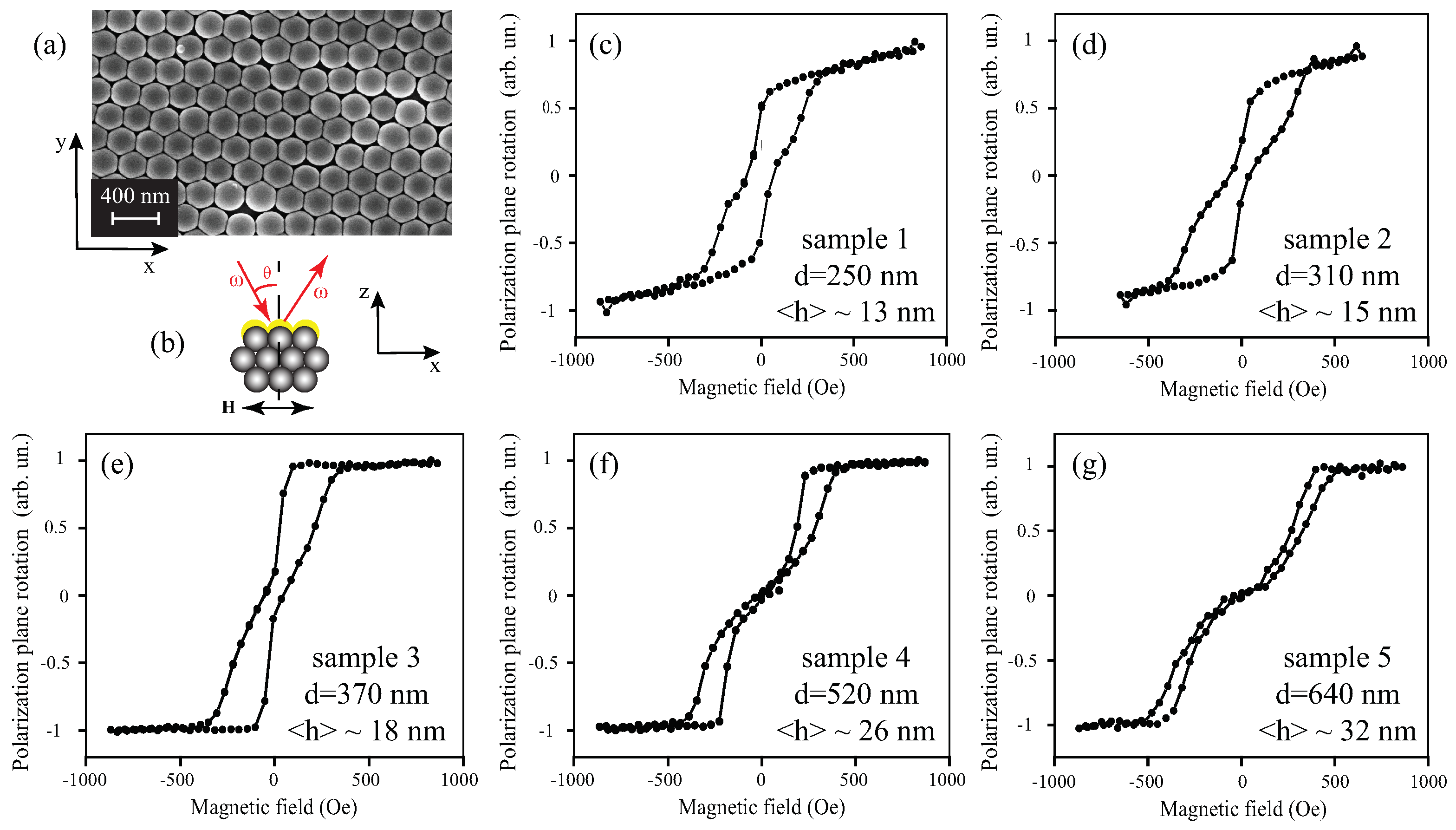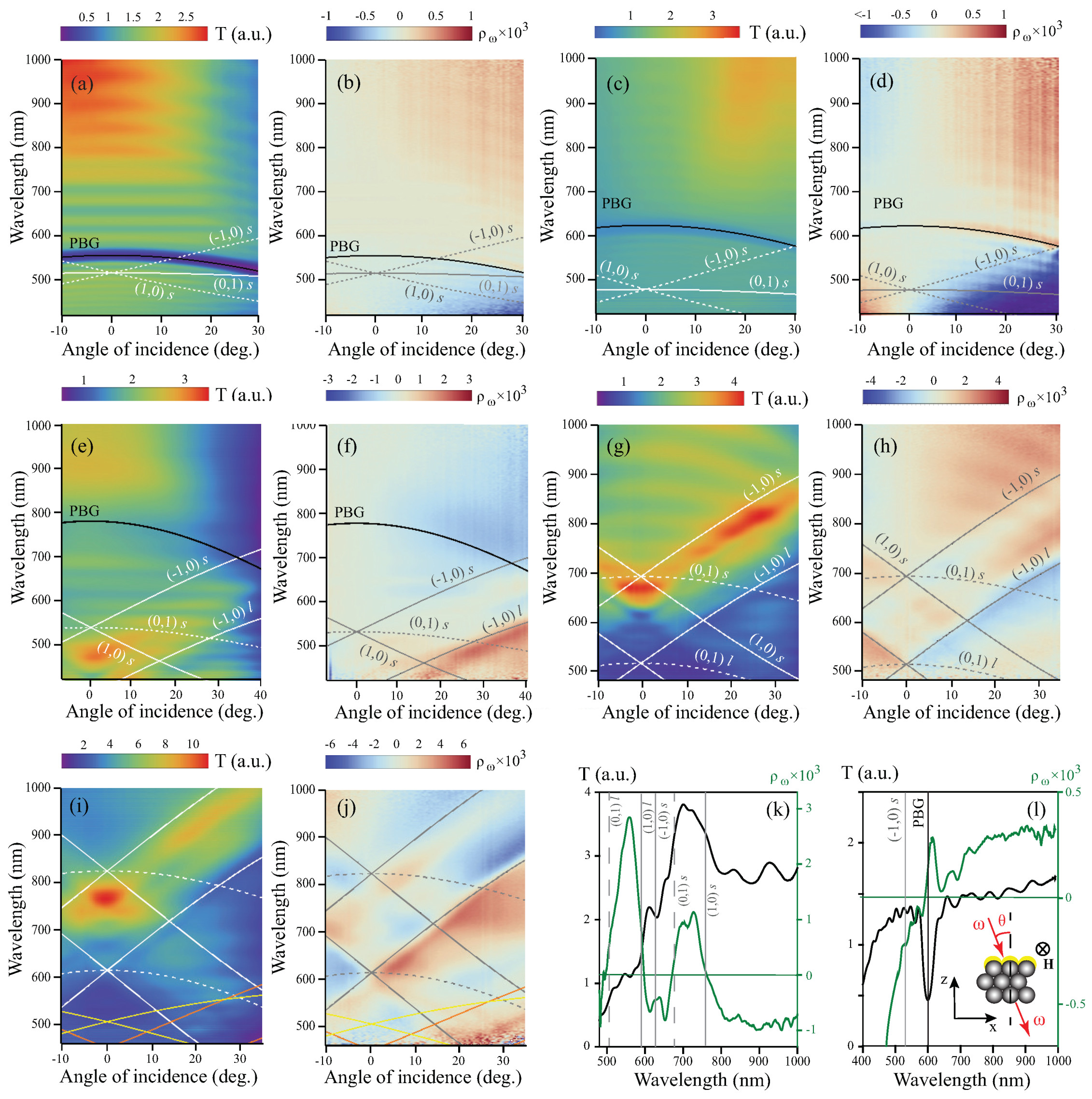Size Effects in Optical and Magneto-Optical Response of Opal-Cobalt Heterostructures
Abstract
:1. Introduction
2. Materials and Methods
3. Experimental Results
4. Calculations
5. Discussion
6. Conclusions
Author Contributions
Funding
Institutional Review Board Statement
Informed Consent Statement
Data Availability Statement
Acknowledgments
Conflicts of Interest
Abbreviations
| MO | magneto-optical |
| PC | photonic crystal |
| PBG | photonic bandgap |
| SPP | surface plasmon-polariton |
| MOKE | magneto-optical Kerr effect |
References
- Klimov, V.V. Nanoplasmonics; Jenny Stanford Publishing: Singapore, 2014. [Google Scholar]
- Zayats, A.V.; Smolyaninov, I.I.; Maradudin, A.A. Nano-optics of surface plasmon polaritons. Phys. Rep. 2005, 408, 131–314. [Google Scholar] [CrossRef]
- Maier, S. Plasmonics: Fundamentals and Applications; Springer: Berlin/Heidelberg, Germany, 2007. [Google Scholar]
- Belotelov, V.I.; Akimov, I.A.; Pohl, M.; Kotov, V.A.; Kasture, S.; Vengurlekar, A.S.; Gopal, A.V.; Yakovlev, D.R.; Zvezdin, A.K.; Bayer, M. Enhanced magneto-optical effects in magnetoplasmonic crystals. Nat. Nanotechnol. 2011, 6, 370–376. [Google Scholar] [CrossRef] [PubMed]
- Chekhov, A.L.; Naydenov, P.N.; Smirnova, M.N.; Ketsko, V.A.; Stognij, A.I.; Murzina, T.V. Magnetoplasmonic crystal waveguide. Phys. Solid State 2013, 55, 1725–1732. [Google Scholar] [CrossRef]
- Landstrom, L.; Brodoceanu, D.; Piglmayer, K.; Bauerle, D. Extraordinary optical transmission through metal-coated colloidal monolayers. Appl. Phys. A 2006, 84, 373–377. [Google Scholar] [CrossRef]
- Landstrom, L.; Brodoceanu, D.; Bauerle, D.; Garcia-Vidal, F.J.; Rodrigo, S.G.; Martin-Moreno, L. Extraordinary transmission through metal-coated monolayers of microspheres. Opt. Express 2009, 17, 761–772. [Google Scholar] [CrossRef] [Green Version]
- Farcau, C.; Astilean, S. Probing the unusual optical transmission of silver films deposited on two-dimensional regular arrays of polystyrene microspheres. J. Opt. A Pure Appl. Opt. 2007, 9, S345–S349. [Google Scholar] [CrossRef]
- Maaroof, A.I.; Cortie, M.B.; Harris, N.; Wieczorek, L. Mie and Bragg Plasmons in Subwavelength Silver Semi-Shells. Small 2008, 4, 2292–2299. [Google Scholar] [CrossRef] [Green Version]
- Ebbesen, T.W.; Lezec, H.J.; Ghaemi, H.F.; Thio, T.; Wolff, P.A. Extraordinary optical transmission through sub-wavelength hole arrays. Nature 1998, 391, 667–669. [Google Scholar] [CrossRef]
- Martin-Moreno, L.; Garcia-Vidal, F.J.; Lezec, H.J.; Pellerin, K.M.; Thio, T.; Pendry, J.B.; Ebbesen, T.W. Theory of Extraordinary Optical Transmission through Subwavelength Hole Arrays. Phys. Rev. Lett. 2001, 86, 1114–1117. [Google Scholar] [CrossRef] [Green Version]
- Belotelov, V.I.; Zvezdin, A.K. Magneto-optical properties of photonic crystals. J. Opt. Soc. Am. B 2005, 22, 286–292. [Google Scholar] [CrossRef]
- Razdolski, I.; Murzina, T.; Khartsev, S.; Grishin, A.; Aktsipetrov, O. Magneto-optical switching in nonlinear all-garnet magnetophotonic crystals. Thin Solid Film. 2011, 519, 5600–5602. [Google Scholar] [CrossRef]
- Aktsipetrov, O.A.; Dolgova, T.V.; Fedyanin, A.A.; Kapra, R.; Murzina, T.V.; Nishimura, K.; Uchida, H.; Inoue, M. Nonlinear Magnetooptics in Magnetophotonic Crystals and Microcavities. Laser Phys. 2004, 14, 685–691. [Google Scholar]
- Gajiev, G.M.; Golubev, V.G.; Kurdyukov, D.A.; Medvedev, A.V.; Pevtsov, A.B.; Sel’kin, A.V.; Travnikov, V.V. Bragg reflection spectroscopy of opal-like photonic crystals. Phys. Rev. B 2005, 72, 205115. [Google Scholar] [CrossRef]
- Romanova, A.S.; Korovin, A.V.; Romanov, S.G. Effect of Dimensionality on the Spectra of Hybrid Plasmonic–Photonic Crystals. Phys. Solid State 2013, 55, 1725–1732. [Google Scholar] [CrossRef]
- Romanov, S.G.; Korovin, A.V.; Regensburger, A.; Peschel, U. Hybrid Colloidal Plasmonic-Photonic Crystals. Adv. Mater. 2011, 23, 2515–2533. [Google Scholar] [CrossRef]
- Pohl, M.; Kreilkamp, L.E.; Belotelov, V.I.; Akimov, I.A.; Kalish, A.N. Tuning of the transverse magneto-optical Kerr effect in magneto-plasmonic crystals. New J. Phys. 2013, 15, 075024. [Google Scholar] [CrossRef] [Green Version]
- Gonzalez-Diaz, J.B.; Garcia-Martin, A.; Armelles, G.; Garcia-Martin, J.M.; Clavero, C.; Cebollada, A.; Lukaszew, R.A.; Skuza, J.R.; Kumah, D.P.; Clarke, R. Surface-magnetoplasmon nonreciprocity effects in noble-metal/ferromagnetic heterostructures. Phys. Rev. B 2007, 76, 153402. [Google Scholar] [CrossRef] [Green Version]
- Ignatyeva, D.O.; Knyazev, G.A.; Kapralov, P.O.; Dietler, G.; Sekatskii, S.K.; Belotelov, V.I. Magneto-optical plasmonic heterostructure with ultranarrow resonance for sensing applications. Sci. Rep. 2016, 6, 28077. [Google Scholar] [CrossRef]
- Pomozov, A.R.; Chekhov, A.L.; Rodionov, I.A.; Baburin, A.S.; Lotkov, E.S.; Temiryazeva, M.P.; Afanasyev, K.N.; Baryshev, A.V.; Murzina, T.V. Two-dimensional high-quality Ag/Py magnetoplasmonic crystals. Appl. Phys. Lett. 2020, 116, 013106. [Google Scholar] [CrossRef]
- Kolmychek, I.A.; Shaimanov, A.N.; Baryshev, A.V.; Murzina, T.V. Magneto-Optical Response of Two-Dimensional Magnetic Plasmon Structures Based on Gold Nanodisks Embedded in a Ferrite Garnet Layer. JETP Lett. 2015, 102, 46–50. [Google Scholar] [CrossRef]
- Sapozhnikov, M.V.; Gusev, S.A.; Troitskii, B.B.; Khokhlova, L.V. Optical and magneto-optical resonances in nanocorrugated ferromagnetic films. Opt. Lett. 2011, 36, 4197–4199. [Google Scholar] [CrossRef] [PubMed]
- Inoue, M.; Fujii, T. Magnetooptical properties of one-dimensional photonic crystals composed of random magnetic and dielectric layers. J. Appl. Phys. 1997, 81, 5659–5665. [Google Scholar] [CrossRef]
- Steel, M.J.; Levy, M.; Osgood, R.M. High transmission enhanced Faraday rotation in one-dimensional photonic crystals with defects. IEEE Photonics Technol. Lett. 2000, 12, 1171–1173. [Google Scholar] [CrossRef]
- Inoue, M.; Uchida, H.; Nishimura, K.; Lim, P.B. Magnetophotonic crystals—A novel magneto-optic material with artificial periodic structures. J. Mater. Chem. 2006, 16, 678–684. [Google Scholar] [CrossRef]
- Ikezawa, Y.; Nishimura, K.; Uchida, H.; Inoue, M. Preparation of two-dimensional magneto-photonic crystals ofbismus substitute yttrium iron garnet materials. J. Magn. Magn. Mater. 2004, 272–276, 1690–1691. [Google Scholar] [CrossRef]
- Zhdanov, A.; Fedyanin, A.; Baryshev, A.; Khanikaev, A.; Uchida, H.; Inoue, M. Magnetoplasmonic effects in 2D magnetophotonic crystals. In Organic Materials and Devices for Displays and Energy Conversion; Optical Society of America: Washington, DC, USA, 2007; p. JWC36. [Google Scholar]
- Pavlov, V.V.; Usachev, P.A.; Pisarev, R.V.; Kurdyukov, D.A.; Kaplan, S.F.; Kimel, A.V.; Kirilyuk, A.; Rasing, T. Enhancement of optical and magneto-optical effects in three-dimensional opal/Fe3O4 magnetic photonic crystals. Appl. Phys. Lett. 2008, 93, 072502. [Google Scholar] [CrossRef] [Green Version]
- Koerdt, C.; Rikken, G.L.J.A.; Petrov, E.P. Faraday effect of photonic crystals. Appl. Phys. Lett. 2003, 82, 1538–1549. [Google Scholar] [CrossRef]
- Grunin, A.A.; Sapoletova, N.A.; Napolskii, K.S.; Eliseev, A.A.; Fedyanin, A.A. Magnetoplasmonic nanostructures based on nickel inverse opal slabs. J. Appl. Phys. 2012, 111, 07A948. [Google Scholar] [CrossRef] [Green Version]
- Pascu, O.; Caicedo, J.M.; Lopez-Garcia, M.; Canalejas, V.; Blanco, A.; Lopez, C.; Arbiol, J.; Fontcuberta, J.; Roig, A.; Herranz, G. Ultrathin conformal coating for complex magneto-photonic structures. Nanoscale 2011, 3, 4811–4816. [Google Scholar] [CrossRef]
- Dokukin, M.; Baryshev, A.; Khanikaev, A.; Inoue, M. Reverse and enhanced magneto-optics of opal-garnet heterostructures. Opt. Express 2009, 17, 9062–9070. [Google Scholar] [CrossRef]
- Pevtsov, A.B.; Grudinkin, S.A.; Poddubny, A.N.; Kaplan, S.F.; Kurdyukov, D.A.; Golubev, V.G. Switching of the photonic band gap in three-dimensional film photonic crystals based on opal-VO2 composites in the 1.3–1.6 m spectral range. Semiconductors 2010, 44, 1537–1542. [Google Scholar] [CrossRef]
- Sapozhnikov, M.V.; Gusev, S.A.; Rogov, V.V.; Ermolaeva, O.L.; Troitskii, B.B.; Khokhlova, L.V.; Smirnov, D.A. Magnetic and optical properties of nanocorrugated Co films. Appl. Phys. Lett. 2010, 96, 122507. [Google Scholar] [CrossRef]
- Sapozhnikov, M.V.; Ermolaeva, O.L.; Gribkov, B.G.; Nefedov, I.M.; Karetnikova, I.R.; Gusev, S.A.; Rogov, V.V.; Troitskii, B.B.; Khokhlova, L.V. Frustrated magnetic vortices in hexagonal lattice of magnetic nanocaps. Phys. Rev. B 2012, 85, 054402. [Google Scholar] [CrossRef] [Green Version]
- Sapozhnikov, M.; Budarin, L.; Demidov, E. Ferromagnetic resonance of 2D array of magnetic nanocaps. J. Magn. Magn. Mater. 2018, 449, 68–76. [Google Scholar] [CrossRef]
- Gonzalez-Diaz, J.B.; Garcia-Martin, A.; Garcia-Martin, J.M.; Cebollada, A.; Armelles, G.; Sepulveda, B.; Alaverdyan, Y.; Kall, M. Plasmonic Au/Co/Au Nanosandwiches with Enhanced Magneto-optical Activity. Small 2008, 4, 202. [Google Scholar] [CrossRef]
- Degiron, A.; Lezec, H.J.; Barnes, W.L.; Ebbesen, T. Effects of hole depth on enhanced light transmission through subwavelength hole arrays. Appl. Phys. Lett. 2002, 81, 4327–4329. [Google Scholar] [CrossRef]
- Kavtreva, O.A.; Ankudinov, A.V.; Bazhenova, A.G.; Kumzerov, Y.A.; Limonov, M.F.; Samusev, K.B.; Sel’kin, A.V. Optical characterization of natural and synthetic opals by Bragg reflection spectroscopy. Phys. Solid State 2007, 49, 708–714. [Google Scholar] [CrossRef]
- Palik, E.D. Handbook of Optical Constants of Solids; Academic Press: San Diego, CA, USA, 2012. [Google Scholar]
- Salomon, L.; Grillot, F.; Zayats, A.V.; de Fornel, F. Near-Field Distribution of Optical Transmission of Periodic Subwavelength Holes in a Metal Film. Phys. Rev. Lett. 2001, 86, 1110–1113. [Google Scholar] [CrossRef]
- Genet, C.; Ebbesen, T.W. Light in tiny holes. Nature 2007, 445, 39–46. [Google Scholar] [CrossRef] [PubMed]
- Zvezdin, A.K.; Kotov, V.A. Modern Magnetooptics and Magnetooptical Materials; CRC Press: Boca Raton, FL, USA, 1997. [Google Scholar]


Publisher’s Note: MDPI stays neutral with regard to jurisdictional claims in published maps and institutional affiliations. |
© 2021 by the authors. Licensee MDPI, Basel, Switzerland. This article is an open access article distributed under the terms and conditions of the Creative Commons Attribution (CC BY) license (https://creativecommons.org/licenses/by/4.0/).
Share and Cite
Kolmychek, I.A.; Lazareva, K.A.; Mamonov, E.A.; Skorokhodov, E.V.; Sapozhnikov, M.V.; Golubev, V.G.; Murzina, T.V. Size Effects in Optical and Magneto-Optical Response of Opal-Cobalt Heterostructures. Materials 2021, 14, 3481. https://doi.org/10.3390/ma14133481
Kolmychek IA, Lazareva KA, Mamonov EA, Skorokhodov EV, Sapozhnikov MV, Golubev VG, Murzina TV. Size Effects in Optical and Magneto-Optical Response of Opal-Cobalt Heterostructures. Materials. 2021; 14(13):3481. https://doi.org/10.3390/ma14133481
Chicago/Turabian StyleKolmychek, Irina A., Ksenia A. Lazareva, Evgeniy A. Mamonov, Evgenii V. Skorokhodov, Maksim V. Sapozhnikov, Valery G. Golubev, and Tatiana V. Murzina. 2021. "Size Effects in Optical and Magneto-Optical Response of Opal-Cobalt Heterostructures" Materials 14, no. 13: 3481. https://doi.org/10.3390/ma14133481
APA StyleKolmychek, I. A., Lazareva, K. A., Mamonov, E. A., Skorokhodov, E. V., Sapozhnikov, M. V., Golubev, V. G., & Murzina, T. V. (2021). Size Effects in Optical and Magneto-Optical Response of Opal-Cobalt Heterostructures. Materials, 14(13), 3481. https://doi.org/10.3390/ma14133481






